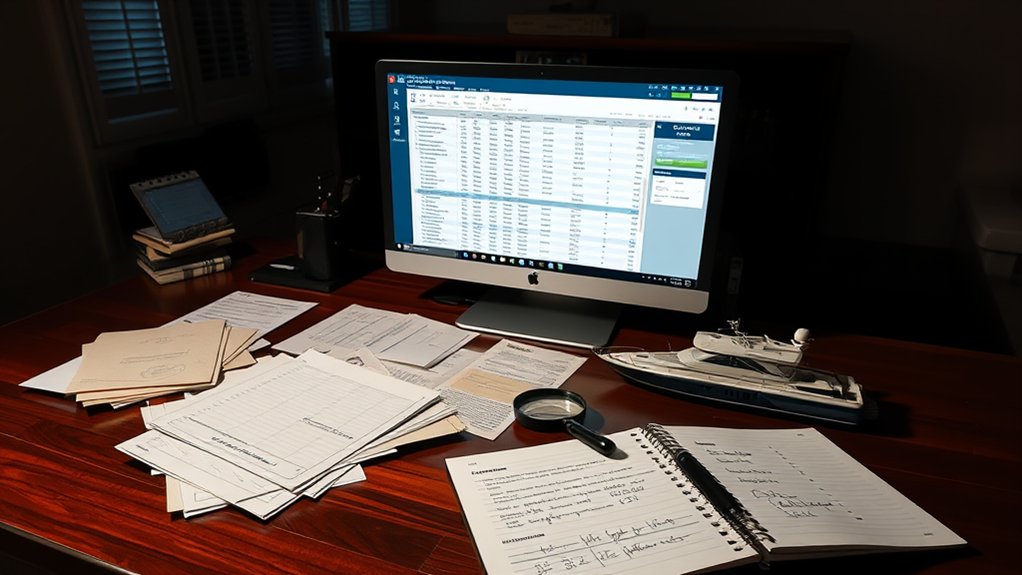Private investigators recover hidden assets through systematic research of public records, financial documents, and digital footprints. They analyze property records, business filings, and bank statements while employing surveillance techniques to track suspicious financial patterns. Digital forensics and social media monitoring reveal lifestyle indicators and asset movement. Professional investigators utilize specialized databases, court-ordered discovery tools, and offshore detection strategies. A thorough investigation exposes complex networks of concealed wealth.
Key Takeaways
- Private investigators analyze public records, financial statements, and property documents to track assets through official channels and databases.
- Digital forensics and social media monitoring reveal lifestyle discrepancies and electronic traces of hidden assets.
- Surveillance techniques document physical evidence of undisclosed assets through photography, video, and observation of suspicious activities.
- Investigators examine corporate structures and offshore accounts to identify shell companies and international fund transfers.
- Legal tools like court orders and subpoenas are used to compel financial institutions to disclose account information.
Public Records and Database Research Techniques

Conducting thorough public records and database research forms the foundation of any hidden assets investigation. Professional investigators utilize sophisticated data mining techniques to analyze multiple sources, including property records, business filings, court documents, and financial statements. Through systematic database searches, investigators can uncover connections between individuals, entities, and assets that may otherwise remain concealed.
Document retrieval from county offices, state agencies, and federal repositories provides critical information about real estate holdings, vehicle registrations, corporate interests, and tax liens. Investigators cross-reference these findings with specialized databases that track banking relationships, investment accounts, and offshore holdings. This methodical approach to public records research often reveals patterns of asset movement, ownership structures, and financial relationships that help locate hidden resources and establish their true ownership.
Skip tracing techniques complement database searches by helping investigators track down assets that have been intentionally concealed or moved across jurisdictions.
Digital Forensics and Electronic Paper Trails
As digital technology continues to dominate financial transactions and record-keeping, digital forensics has become an essential component of hidden assets investigations. Investigators employ sophisticated data recovery techniques to analyze digital footprints left behind in electronic communications, financial software, and online transactions. Through encryption analysis and specialized forensic tools, investigators can often recover deleted files, access archived data, and trace the movement of assets across digital platforms. The 8-hour device analysis timeframe allows investigators to quickly examine mobile devices and computers for evidence of asset transfers while maintaining chain of custody.
- Recovery of deleted emails, messages, and documents that may reveal asset transfers or hidden accounts
- Analysis of metadata from financial documents to establish patterns and identify undisclosed holdings
- Examination of cryptocurrency transactions and blockchain records to trace digital currency movements
- Investigation of cloud storage services and backup systems that might contain evidence of concealed assets
Financial Statement Analysis and Bank Records
Financial investigators analyze cash flow patterns across multiple accounts to identify suspicious movement of funds and potential asset concealment. Bank record examination reveals transaction timing, frequency, and amounts that may indicate structured deposits or withdrawals designed to avoid detection thresholds. Cross-referencing financial statements with banking activity exposes discrepancies between reported income and actual funds, helping trace hidden account transfers through intermediary institutions. Thorough background checks through Fair Credit Reporting Act compliance ensure proper authorization when accessing sensitive financial records during asset investigations.
Examining Cash Flow Patterns
The examination of cash flow patterns serves as an essential investigative tool in uncovering hidden assets through thorough analysis of financial statements and bank records. Private investigators scrutinize transaction analysis to identify irregularities, suspicious patterns, and potential diversions of funds. By mapping the movement of money across accounts and time periods, investigators can detect concealed wealth and trace its destination.
- Regular withdrawals or transfers that don’t align with known expenses or income sources
- Sudden changes in cash flow patterns that coincide with significant life events or legal proceedings
- Circular transactions between multiple accounts that may indicate attempts to obscure fund origins
- Unexplained gaps in transaction sequences that could suggest the existence of undisclosed accounts or assets
Tracing Hidden Account Transfers
Tracing hidden account transfers requires investigators to meticulously analyze financial statements and bank records for evidence of asset concealment across multiple accounts and institutions. Investigators scrutinize transaction patterns, deposit frequencies, and withdrawal amounts to identify hidden transactions that may indicate attempts at financial anonymity.
The investigation process involves cross-referencing bank statements with other financial documents, including wire transfer records, canceled checks, and electronic fund transfers. Particular attention is paid to round-dollar transactions, multiple transfers between accounts on the same day, and transactions just below reporting thresholds. Investigators also examine relationships between seemingly unrelated accounts by mapping transaction flows and identifying common beneficiaries or intermediaries that may be used to obscure the true movement of assets.
Asset Search Through Property Records
Searching through property records serves as a fundamental step in uncovering hidden assets, offering investigators documented evidence of real estate ownership, transfers, and liens. Through thorough real estate analysis, investigators examine ownership history across multiple jurisdictions to identify patterns, questionable transfers, and potential shell companies.
- County recorder offices maintain detailed records of property transactions, mortgages, and tax assessments that reveal asset ownership
- Cross-referencing deeds, titles, and tax records helps identify properties transferred to family members or business associates
- Investigators analyze mortgage documents to uncover hidden income streams and financial relationships
- Public records searches can reveal undisclosed properties in different states or countries, particularly when combined with business entity records
This systematic approach allows investigators to construct a thorough picture of property holdings and identify assets deliberately concealed through various ownership structures.
Specialized surveillance equipment enhances investigators’ ability to document property conditions and gather evidence of occupancy or misuse during fraud investigations.
Social Media Investigation Methods

Investigators utilize social media platforms to monitor posts, stories, and status updates that may reveal concealed assets through lifestyle indicators and spending patterns. Digital footprint analysis examines online behaviors across multiple platforms to identify discrepancies between declared financial status and actual expenditures. The systematic collection and analysis of public social media content can expose hidden real estate, vehicles, vacations, or business interests that conflict with documented asset declarations. Careful metadata examination provides critical context through embedded timestamps and geolocation data that can help trace asset movements and ownership patterns.
Monitoring Posts and Stories
Diligent monitoring of social media posts and stories can reveal valuable intelligence about hidden assets and financial activities. Professional investigators employ systematic social media tracking to identify patterns, locations, and lifestyle indicators that may expose undisclosed wealth. Through influencer monitoring and thorough analysis of digital footprints, investigators can uncover evidence of luxury purchases, travel, properties, and business relationships.
- Cross-referencing timestamps and geotags from multiple platform posts to establish timeline consistency
- Analyzing story highlights and archived content for historical spending patterns
- Examining tagged accounts, business partnerships, and sponsored content for undisclosed income sources
- Documenting lifestyle inconsistencies between declared finances and social media displays
Regular monitoring helps investigators build a detailed profile of an individual’s true financial status, often revealing discrepancies between reported and actual assets.
Digital Footprint Analysis
Through thorough analysis of digital footprints, professional asset recovery teams can uncover intricate patterns of financial activity and asset concealment across social media platforms. These investigators employ sophisticated data mining techniques to examine posting habits, check-ins, and photo metadata, revealing potential asset locations and lifestyle indicators.
Online behavior analysis plays an essential role in building extensive profiles of subjects under investigation. By examining social connections, group memberships, and interaction patterns, investigators can identify networks of associates who may be involved in asset concealment. The correlation of timestamps, locations, and digital interactions often exposes discrepancies between declared financial status and actual wealth. This methodical approach helps investigators track hidden assets while maintaining compliance with legal and ethical guidelines.
Surveillance and Physical Monitoring

When pursuing hidden assets, surveillance and physical monitoring serve as critical tools for gathering actionable intelligence about a subject’s activities, lifestyle, and potential undisclosed resources. Professional investigators conduct covert operations to document patterns, interactions, and financial transactions that may reveal hidden wealth. Through systematic behavior analysis, investigators can identify discrepancies between reported income and observed spending habits.
- Mobile surveillance tracking subject’s movements to luxury locations, high-end retailers, or private storage facilities
- Documentation of assets through photography and video, including vehicles, properties, and valuable possessions
- Monitoring of regular activities to establish patterns of financial transactions and business relationships
- Observation of meetings with potential associates, business partners, or financial advisors who may be involved in concealing assets
Stillinger Investigations employs state-of-the-art technology for advanced surveillance and real-time evidence collection to ensure thorough documentation of hidden assets.
Business Entity and Corporate Investigations
Corporate records research forms the foundation of business entity investigations, enabling investigators to trace ownership structures and identify potential shell companies used to conceal assets. Through systematic examination of incorporation documents, annual reports, and regulatory filings, investigators can map complex corporate hierarchies and reveal interconnections between business entities. This documentation analysis often exposes shell companies operating as asset-holding vehicles, leading investigators to hidden bank accounts, real estate holdings, and other valuable assets. Forensic accounting techniques help investigators detect financial statement irregularities that could signal fraudulent asset concealment.
Corporate Records Research
Investigation of corporate records represents a critical component in hidden assets recovery, enabling investigators to uncover valuable information about business entities and their financial activities. Through systematic examination of official documentation, investigators analyze corporate compliance records and scrutinize asset protection strategies employed by businesses. This research reveals ownership structures, financial transactions, and potential attempts to conceal assets through corporate entities.
- Analysis of Articles of Incorporation, annual reports, and amendments to identify key stakeholders and organizational changes
- Review of corporate tax filings, financial statements, and regulatory disclosures
- Examination of UCC filings, liens, and property records associated with the business
- Investigation of corporate minutes, board resolutions, and internal documentation revealing significant business decisions and transactions
Shell Company Asset Tracing
Tracing assets through shell companies demands sophisticated investigative techniques to expose concealed ownership structures and financial flows. Investigators employ extensive shell company identification methods to map interconnected business entities and their beneficial owners. This process involves analyzing incorporation documents, registered agent relationships, and shared business addresses.
Corporate structure analysis reveals patterns of ownership transfer and asset movement between affiliated entities. Investigators scrutinize transaction records, bank statements, and international wire transfers to establish links between shell companies and their controlling parties. They document nominee directors, cross-border relationships, and suspicious financial patterns that may indicate deliberate asset concealment. By meticulously connecting these data points, investigators can reconstruct complex ownership networks and identify where assets have been strategically positioned to avoid detection.
Interviews With Associates and Witnesses
Conducting thorough interviews with associates, business partners, and witnesses remains a significant component of hidden assets recovery investigations. Investigators strategically gather witness statements and conduct associate interviews to uncover valuable information about concealed assets, financial patterns, and suspicious transactions. These conversations often reveal essential details about lifestyle changes, spending habits, and undisclosed business relationships. The application of digital forensics expertise helps validate and corroborate information gathered during witness interviews for stronger evidence collection. Investigators employ structured interview techniques to extract specific details about asset transfers, property ownership, and financial activities. Former employees and business partners frequently provide insights into hidden accounts, shell companies, and asset movement patterns. Family members and close associates may unknowingly possess key information about asset locations and transfer methods. Witness cooperation often leads to documentary evidence, such as bank statements, property records, and correspondence that supports asset recovery efforts.
Offshore Account Detection Strategies
Modern offshore account detection requires a sophisticated array of surveillance techniques, data analysis tools, and international cooperation frameworks. Investigators utilize specialized software to track international wire transfers and monitor suspicious financial patterns that may indicate hidden asset overseas activities. They leverage relationships with foreign banking institutions and regulatory bodies to penetrate account secrecy barriers.
Advanced data mining techniques allow investigators to cross-reference public records, tax filings, and banking transactions across multiple jurisdictions. They analyze corporate structures, trust arrangements, and shell companies to identify beneficial ownership. Through established networks of international investigators and financial intelligence units, they can often trace funds moving through multiple offshore jurisdictions. This methodical approach, combined with adherence to international banking regulations and treaties, enables successful detection of concealed offshore accounts. Professional investigators ensure thorough examination of complex financial frameworks while maintaining strict confidentiality throughout the asset recovery process.
Legal Tools and Court-Ordered Discovery Process
Once investigators identify potential offshore accounts, legal professionals employ a thorough set of judicial tools to compel disclosure and documentation. The court-ordered discovery process provides structured means to exercise legal rights and obtain vital financial information from uncooperative parties. Through formal requests, attorneys can demand specific records, conduct depositions, and utilize subpoenas to enforce discovery obligations.
- Court orders for production of documents, including bank statements, tax returns, and transfer records
- Interrogatories requiring written responses under oath about asset locations and transactions
- Depositions of account holders, financial advisors, and other relevant parties
- Subpoenas to financial institutions and third parties who may possess essential documentation
This systematic approach guarantees thorough investigation while maintaining compliance with legal procedures and jurisdictional requirements across different banking systems.
Licensed private investigators utilize specialized tools and resources to support attorneys throughout the discovery process.
Frequently Asked Questions
How Much Does a Typical Asset Recovery Investigation Cost?
Asset recovery investigation expenses typically range from $3,000 to $15,000, depending on cost factors like case complexity, location scope, required resources, and time investment needed for thorough research.
Can Private Investigators Legally Access Someone’s Personal Banking Information?
Private investigators must respect data privacy laws and cannot directly access personal banking records without consent or court orders. Investigation ethics require following legal channels for financial information.
What Is the Success Rate of Recovering Hidden Assets?
Success rates for hidden asset recovery vary widely, with success factors including asset types, jurisdiction, and documentation quality. Recovery challenges like offshore accounts and complex ownership structures affect overall outcomes.
How Long Does an Average Asset Recovery Investigation Take?
Asset recovery investigation duration typically ranges from three to six months, depending on asset identification complexity, jurisdictional factors, and cooperation levels between involved parties during the process.
Are Recovered Assets Taxable When Found and Returned to Rightful Owners?
Recovered assets generally maintain their original tax implications based on asset ownership status. If previously reported, most recoveries aren’t taxable, though unreported income or appreciation may trigger tax obligations.
Conclusion
Private investigators employ an extensive arsenal of investigative techniques to uncover hidden assets. Through meticulous analysis of public records, digital forensics, financial documentation, and strategic interviews, they piece together complex asset trails. When combined with legal discovery processes and expertise in offshore financial structures, these methods enable investigators to locate concealed wealth, properties, and business interests that subjects attempt to shield from detection.






